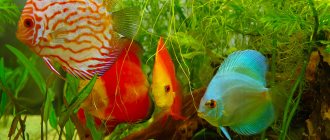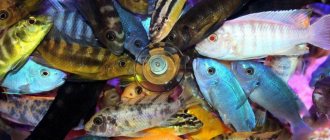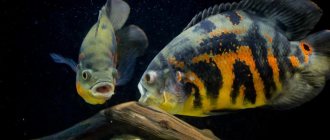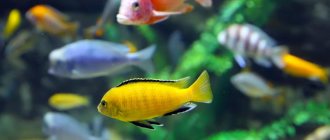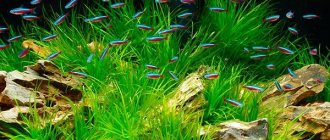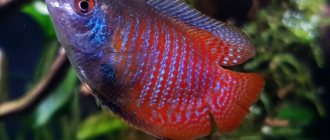Which cichlids are considered dwarf?
To simplify the classification, all cichlids are conditionally divided into groups - large, medium and small. Among the latter, a separate category has emerged in recent years - dwarf cichlids. Photos and descriptions of these beautiful fish will pleasantly surprise any connoisseur. However, some experts may be interested: on what basis are some cichlids classified as dwarf and others not?
First of all, as the name implies, you should pay attention to the size. Males in most cichlid species are larger than females. Therefore, it is customary to focus on them. If their maximum length is no more than 12 centimeters, then this variety is usually classified as dwarf.
However, although size is one of the most important factors, it is not the only one. It is also customary to monitor the behavior of the fish. The dwarf group includes only species in which the majority of representatives are calm and peaceful. That is, a mandatory requirement is high compatibility - so that the fish do not pose a danger to neighbors in a small aquarium, such as themselves or smaller ones.
Species diversity
Few families can boast of such an abundance of different breeds. Among the South American cichlids, aquarists are interested in the following fish:
- bluish-spotted acara – 10-15 cm striped fish with a grayish-brown body and golden-greenish scales;
- Nannakar anomaly – angry fish (5-7 cm), which can keep other, even larger inhabitants at bay, but the bronze-green color of the males, against which there are dark spots, is captivating;
- Ramiresi's apistograms – bright, yellow individuals with purple and greenish metallic tints; she is considered the most beautiful dwarf cichlid;
- black-striped cichlasoma – a visitor from the lakes of Guatemala, which is called a zebra because of its vertical black stripes;
- angelfish – one of the most common representatives of the cichlid family, having an unusual body shape in the form of a flat triangular crescent;
- discus - fastidious and incredibly beautiful, for which they were called the kings of the aquarium world. These fish have a flat, round disc-like body and luxurious colors - both natural and resulting from selection;
- astronotuses – even in captivity, the fish grow up to 20-25 cm, which allows them to be called large inhabitants of the aquarium, and have a bright appearance – their body is decorated with yellow or orange stripes and spots.
Many African cichlids have also successfully adapted in captivity and are loved by aquarists:
- handsome chromis - a selfish, territorial and aggressive inhabitant, but at the same time possessing charisma and incredible beauty - his bright red body is covered with blue-greenish dots that glow;
- pelmatochromis pulcher – like all cichlids, it has a stern disposition. Representatives of the breed are also called crebentis or parrots. There are several varieties, and some of them have very original colors;
- labidochromis yellow – an endemic fish from Lake Malawi, with a bright yellow color with a contrasting black edging;
- haplochromis venustus - another breed from Malawi, representatives of which in captivity reach 25 cm; males can be distinguished due to luxurious blue markings on the cheeks and fins;
- melanochromis auratus - is one of the most prominent representatives of Malawian pugnacious cichlids. Individuals have pronounced sexual dimorphism - the body of the male is painted black, and it is crossed by a white stripe, while in females the stripe is black, located on a light-colored body.
This is only a small part of the cichlids that managed to charm breeders and attract the attention of aquarium owners. In total there are more than 1200 varieties.
Where do they live?
Before talking about the types of dwarf cichlids, it is worth briefly mentioning their habitat.
It's quite big. On sale you can see fish native to Asia, Africa and South America. Of course, this provides a huge variety: if you describe the species of dwarf cichlids, you would have to write an entire book. This can safely include about fifty families of aquarium fish, each of which includes several species.
Most of them live in rivers with weak currents or small lakes. Small sizes leave a certain imprint on the behavior of fish. They live in flocks and prefer secluded corners - overgrown with thick algae or near snags. Which is understandable - in the wild, many predators do not refuse to feast on fish 5-10 centimeters in size. Of course, this must be taken into account when designing an aquarium if you want the inhabitants to feel as comfortable as possible, live long and produce healthy offspring.
Description and features
Cichlids are a separate family of ray-finned fish. Previously, they were classified as perciformes, which reflects their German name “pied perches.” The family has about 1900 species.
Habitat
Most cyclids live in freshwater bodies around the world, mainly in Africa and Latin America, but they are especially numerous in Lake Malawi, where at least 850 species can be counted. This is more species of fish than can be found in all the freshwater bodies of Europe combined. Some species can live in brackish water in river deltas, and even spend some time in the ocean.
History of discovery
The history of artificial breeding of cichlids is very long. It began with the keeping of tilapia in Ancient Egypt and Assyria several thousand years ago.
The modern fascination with aquarium cichlids dates back to the description of the animal diversity of Lake Malawi in 1859 by Scottish explorer and missionary David Livingstone.
Appearance
The wide variety of species of these fish has led to significant differences in their appearance. But they all have two main differences from other bony fish: one pair of nostrils and two lateral lines.
The body contours of cichlids sometimes take on the most bizarre shapes, and depend mainly on the type of food. Predators have a more elongated, streamlined body, while peaceful species are often laterally flattened and relatively vertical, allowing them to quickly hide among algae.
These fish often have unusual colors, such as spots or stripes. Sometimes it occurs only during the spawning period or when the composition of the water changes. African species are often very brightly colored.
The size of the fish ranges from two centimeters to one meter.
Cichlids of South America
If we start talking about the varieties of dwarf cichlids imported from South America, then first of all it is worth noting that they are the most numerous. The size range is also quite large. The smallest is Apistogrammoides - in this species, males rarely have a body length of more than four centimeters. But there are also quite large representatives of cichlids. For example, in the families Apistogramma, Guianacara and Tahuantinsuyoa, males grow up to 12 centimeters. By the way, the dwarf cockatoo cichlid, a fairly popular aquarium fish that enjoys considerable popularity among connoisseurs, belongs to the Apistogram family.
Guests from Africa
African cichlids are slightly larger than their South American relatives. The average size here ranges from 8 to 12 centimeters.
Representatives of the Nanochromis family are considered the smallest. It includes eight species of fish, but even the largest males have a body length of no more than seven centimeters. But the complete opposite of them are Etia and Pelmatochromis. Some of their males reach 14 centimeters, which is why, according to the existing system, they should not be included in the number of dwarf cichlids at all. However, in all other characteristics they are quite consistent - peaceful, calm, males strongly resemble females. Because of this, experts decided to make a small exception for them by enrolling them in the appropriate group.
Compatibility
Before purchasing cichlids, it is necessary to thoroughly study the characteristics of this species, as many of them cannot be placed in one tank due to their uncooperative nature. Some have a preference for plants, others will actively eat their neighbors, although most breeds are only aggressive during the spawning period.
It is unwise, for example, to keep several male parrot cichlids together, since one will definitely be the leader and will not calm down until he gets rid of the rest of his brothers.
The best condition for cichlids to live in an artificial reservoir is to organize a species aquarium, where certain natural pictures of South American, African or Asian underwater flora and fauna are recreated.
It is unwise to populate an artificial reservoir with these aggressive inhabitants and other peaceful species. But angelfish, for example, are much calmer than other cichlids; they can be combined with swordtails, mollies, platies, gourami, zebrafish, cockroaches, and corydoras.
Fish from Asia
The Asian family is the smallest. Science knows only three species of dwarf cichlids, whose homeland is Asia. Because of this, some experts prefer not to even separate them into a separate group. However, it will still be useful to learn about them.
We list all three species: Etroplus Cuvier, Iranocichla hormuzensis Coad and Etroplus maculatus. They have been known for a long time. For example, Etroplus maculatus was discovered at the end of the eighteenth century! It is not surprising that they became popular in many countries a long time ago. They were actively bred in our country - even before the 1917 revolution!
All of them cannot boast of large sizes - the largest males are about 8 centimeters long. And in other respects they are quite consistent with the features that unite dwarf cichlids. Therefore, despite their small numbers, they can be confidently called standard representatives of the family.
Choosing the right water
In general, aquarium dwarf cichlids are not too demanding of water. Throughout their history, they lived in relatively soft fresh water, often not very clean. Therefore, there will be no special problems here.
Soft water with a slight deviation towards acidity is considered optimal - pH 6.5. But they are quite picky about temperature. Still, in their natural environment, fish live in the tropics and even the equator. Therefore, it is very important to ensure that the temperature does not fall below +25 degrees, but in general it is better that it is consistently one to three degrees higher. In general, fish can survive at temperatures around +23, but in this case they will eat worse and get sick more often. Growth slows down, the color scheme becomes scarcer - the fish will no longer be so bright and attractive. They either do not go to spawn at all, or do it quite rarely. Therefore, if the apartment is not warm enough, purchasing a heater will be very useful.
But the most dangerous are temperature changes. Even a fluctuation of just two or three degrees can cause serious illness and even death of fish. Therefore, it is advisable to install the aquarium at a distance from windows and heating radiators. And also protect it from drafts. Only in this case can the aquarist be sure that his pets will be healthy and will delight the owner not only with a riot of colors, but also with healthy offspring.
How to set up an aquarium?
The next stage is the proper design of the aquarium. On the one hand, it provides cichlids with maximum comfort. On the other hand, it will highlight their external attractiveness.
Let's start with the ground. In general, there are no preferences here - you can choose either coarse sand or small pebbles. Cichlids do not have the habit of digging in the ground, so here it is more likely to adapt to the algae that you have chosen for the aquarium. The only thing to consider is its color. The darker the fish, the lighter the soil should be. However, every novice aquarist already knows this rule, so there is no point in focusing on it.
There will also be no problems when choosing algae. Any plants that can grow densely enough to provide the fish with a cozy and safe haven will work well. As mentioned above, in the wild, dwarf cichlids often hide from predators in aquatic plants. Of course, there is no such threat in an aquarium, but still the fish feel more comfortable in the thickets. However, this does not mean that you need to plant the entire available area with algae. You can either densely plant one corner (about one third or a quarter of the aquarium's area), leaving the rest of the area free, or plant the plants against the back wall, leaving plenty of open space in front. After all, cichlids, although calm, are quite active fish, and it is advisable to give them enough space for play and active swimming.
It would be useful to use various elements for decoration - large stones (the main thing is that they do not have sharp edges that could injure the fish) or specially treated driftwood. Thanks to them, the aquarium will acquire special elegance and elegance, and the cichlids will feel at home. But it is not advisable to use sinks. Over time, they increase the hardness of the water, and cichlids prefer soft water.
Reproduction
Pelvicachromis form pairs for life. If a flock of young individuals is acquired, then the choice of a companion occurs by itself without the participation of the owner.
If the fish are initially purchased for breeding, then you should take the choice of a pair seriously .
The female and the male may turn out to be from different pairs and not accept each other, then the female chases the male during any attempts at intimacy.
Sex differences
Pelvikachromis are capable of reproduction from the age of 6 months , when obvious sexual differences are visible.
The female has shorter fins, and has a yellow stripe on her back that spans almost the entire width. The belly is rounded, in many species it is decorated with a pink spot, which becomes even brighter during the spawning period.
Males are more fit, longer than females, their fins are elongated and only bordered along the edge with a yellow line.
Breeding procedure
When preparing a couple for reproduction, their diet includes an abundance of live food.
You can completely switch your fish to frozen or fresh brine shrimp, daphnia, and bloodworms .
Readiness for spawning is visible by the even greater brightness of the color, especially the belly of females. The pair becomes aggressive towards their neighbors who claim shelter for laying eggs.
That is why it is better to equip a separate aquarium with many caves and grottoes - a spawning tank .
Reproduction in a community aquarium may be unsuccessful for one more reason: adult fish eat larvae and swimmable fry.
Interesting! Caring future parents prepare a shelter for the young in advance and can push pebbles or other debris out of the cave.
Requirements for the spawning tank
If the spawning tank is intended to be used only for laying eggs, then it is enough to take a container with a volume of 20–30 liters.
When growing juveniles live in the same aquarium, it is better to have a reserve of another 10–20 liters.
The water must always be clean , for which a filter with a sponge and a compressor are installed.
But a special lamp is not necessary - the fish will feel safer in dim daylight.
At the bottom, as in a general aquarium, it is necessary to pour soil, strengthen grottoes or caves, and plant plants.
Spawning
Laying eggs begins when the female swims into a prepared shelter, turns over with her stomach up and rubs it against the upper surface of the cave.
After this, the male comes to the rescue and repeats the same movements. So spawning continues for about an hour . It’s strange, but after the first such approaches, parents can eat the caviar themselves.
As a result, 200–300 eggs . The female can spend the entire time before the larvae hatch in the shelter, sometimes swimming out while feeding.
During this period, the male waits outside and protects the offspring from enemies.
Fry
After 3–7 days, the eggs hatch into fry, which remain motionless.
When the juveniles become active, the mother does not release the offspring from the shelter for a long time, dragging the naughty offspring back with her mouth.
Parents protect their offspring by regulating the height of their rise to the surface and the distance of their walks.
The fry should be fed with brine shrimp larvae or a special industrial dry composition..
Interesting! When the water acidity is 7.0 pH, the offspring have the same number of fry of both sexes. When this indicator shifts to the acidic side, females predominate, and to the alkaline side, males predominate.
Maintaining cleanliness in the spawning area becomes the main task of the owner during this period. It is necessary to install a sponge filter, a compressor and change a quarter of the water volume every other day.
After a month, the fry reach a length of 1 cm . The juveniles are first colored with small black speckles, and by 2 months the dots merge into stripes. The fish become similar to adults only by 4 months.
Suitable nutrition
But with nutrition, it’s not easy to give unambiguous advice. If only because among dwarf cichlids there are both species that prefer plant food and predatory ones. Therefore, the diet should be prepared accordingly.
However, for everyone, live food will be the best choice - bloodworms, tubifex, brine shrimp, and for the smallest species, cyclops is also suitable. Thanks to this diet, the inhabitants of the aquarium will receive all the necessary substances for a comfortable life and reproduction. But when choosing herbivorous fish, it would be useful to add some greens to the diet - they need more vitamins, which are difficult to obtain from animal food.
Of course, in extreme cases, fish can live on dry food - even on daphnia and gammarus. But a long absence of live food worsens the well-being of cichlids. Therefore, if it is not possible to get bloodworms and tubifex, try to at least pick up special granules - they are better balanced and contain almost all the necessary vitamins and microelements.
Diseases - prevention and treatment
Cichlids are quite strong fish. All diseases are usually associated with improper keeping of cichlids. For them, the cleanliness of the aquarium, its volume, compliance with temperature conditions and nutritious food are very important.
It is also important to observe the quarantine regime for new plants and soil, new inhabitants of the aquarium and live food.
Types of diseases
The most common diseases of cichlids:
- hexamitosis is an enlargement of the pores on the head and along the lateral line; the fish stop eating and become weaker; they can be cured with metronidazole, but the disease cannot be neglected;
- ichthyophthiriasis or semolina - white plaque on the skin; treated with quinine hydrochloride;
- American bloat - the body of the fish inflates, the eyes become bulging; fish stop eating and become lethargic; treated with antibiotics;
- saprolegniosis – growths appear on the body; treated with phenoxyethanol.
Optimal care
Cichlids are relatively unpretentious in care. It is enough to clean regularly - ideally half an hour after each feeding. However, if there are bottom fish in the aquarium that will collect the remains of the cichlids’ meal, you can reduce the number of cleanings to one per week.
In any case, you need to change some of the water weekly. Not too much - no more than one fifth of the total volume of the aquarium. Of course, the water must be at a suitable temperature and not contain chlorine. Therefore, it is advisable to settle the water - taking cold water from the tap, let it stand for a day or two in an enamel bucket. Then the temperature will rise to room temperature, and the chlorine will gradually evaporate.
There will probably be no other hassle during maintenance. Despite their sonorous and incomprehensible names, aquarium cichlids require quite little attention.
Diseases
Diseases in fish appear from poor water quality, constant stress or infection through low-quality feed.
- A yellow film may appear on the body - this is a sign of oodinosis. The treatment is carried out by a specialist.
- If whitish crusts appear on the scales, this indicates the development of ichthyophthyriosis . Treatment will require copper preparations and a half-volume water change.
- Fish can even be affected by tuberculosis - pelvicachromis lives motionlessly at the bottom and practically does not eat.
- Just like humans, fish can become obese if overfed. It is important to immediately notice weight gain and balance your diet.
Pelvicachromis is easy to keep. It is enough to choose the right diet, change the water sometimes and take timely measures to treat diseases.
We select neighbors
However, few aquarists, having got cichlids and populated the aquarium with them, decide to leave them in splendid isolation. Most people will be interested in having neighbors move in with them. But here you need to be careful so that the neighborhood does not cause trouble to either side or the other.
First of all, we should recommend catfish. Cichlids rarely sink to the bottom. Therefore, the bottom area will still be empty. Several large catfish will perfectly smooth out the void, and at the same time eat the remaining food that has settled to the bottom. Thanks to this, cleaning will have to be done much less often.
Many cyprinids can be a good choice. The main thing is to make sure that they are not too aggressive. For example, a flock of barbs will quickly make life completely unbearable for the unfortunate cichlids. Choose medium-sized, calm, peace-loving fish. You can also recommend not too large characoid fish, as well as melanotenia. Representatives of most other families will not make good neighbors for cichlids.

